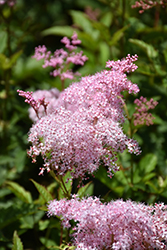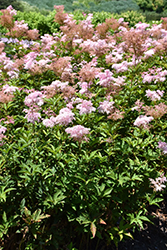>> Home
Height: 5 feet
Spread: 32 inches
Sunlight:
![]()
![]()
Hardiness Zone: 2b
Other Names: Meadowsweet
Description:
Blooming from early to mid summer, fragrant pale plumes of small flowers bloom on tall, branchy, upright stems; excellent for beds, cutting gardens or adding to dried bouquets; easy to grow, requiring little maintenance
Ornamental Features
Queen Of The Prairie features delicate panicles of shell pink flowers with red anthers at the ends of the stems from early to mid summer, which emerge from distinctive pink flower buds. The flowers are excellent for cutting. Its serrated narrow compound leaves remain emerald green in colour throughout the season.
Landscape Attributes
Queen Of The Prairie is an herbaceous perennial with an upright spreading habit of growth. Its relatively fine texture sets it apart from other garden plants with less refined foliage.
This is a relatively low maintenance plant, and is best cleaned up in early spring before it resumes active growth for the season. Deer don't particularly care for this plant and will usually leave it alone in favor of tastier treats. It has no significant negative characteristics.
Queen Of The Prairie is recommended for the following landscape applications;
- Mass Planting
- General Garden Use
Planting & Growing
Queen Of The Prairie will grow to be about 4 feet tall at maturity, with a spread of 32 inches. It tends to be leggy, with a typical clearance of 1 foot from the ground, and should be underplanted with lower-growing perennials. It grows at a medium rate, and under ideal conditions can be expected to live for approximately 10 years. As an herbaceous perennial, this plant will usually die back to the crown each winter, and will regrow from the base each spring. Be careful not to disturb the crown in late winter when it may not be readily seen!
This plant does best in partial shade to shade. It prefers to grow in moist to wet soil, and will even tolerate some standing water. It is not particular as to soil pH, but grows best in rich soils. It is somewhat tolerant of urban pollution. Consider applying a thick mulch around the root zone over the growing season to conserve soil moisture. This species is native to parts of North America. It can be propagated by division.

